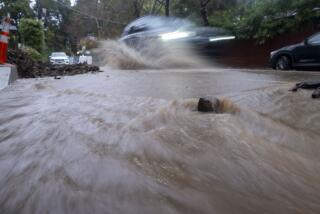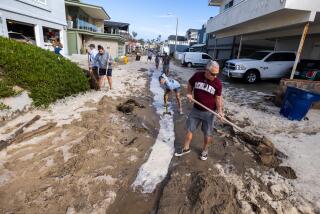County Is Declared Federal Disaster Area
- Share via
VENTURA — As Ventura County’s storm damage rose to at least $36 million, President Clinton declared the county a federal disaster area Monday, qualifying local residents and business owners for a variety of emergency relief.
The president’s declaration of a state of emergency in Ventura and 26 other California counties is significant because it offers aid far broader than under the state disaster declaration issued last week.
“That’s real good news, especially for residents and businesses,” said Laura Hernandez, manager of the county Office of Emergency Services. “It will also offset some of the emergency costs of the cities and county.”
Across the state, damage from the recent storms is estimated at $275 million to $300 million, and that includes only 22 of the 27 counties affected, said Richard Andrews, director of the state Office of Emergency Services.
The federal declaration allows storm victims to apply for grants to cover temporary housing and minor home repairs; unemployment benefits for jobs lost; grants of up to $13,400 for other needs; and low-interest loans to homeowners and shopkeepers for major building repairs.
No new storm is on the immediate horizon, although forecasters say there is a 20% chance of rain tonight, and a more substantial weather system may roll in by Friday. But neither will approach the power of the torrential rains of the last week, they said.
After five large storms in 10 days dumped almost a winter’s worth of rain on the county, emergency officials upped the countywide damage estimate from $8.5 million last week to $36 million and rising on Monday--with local farmers absorbing most of the loss.
“It’s amazing this is adding up to so much,” Hernandez said. “It’s fair to say we’re at the $36-million damage mark here. And these figures do not include damage to state highways or federal properties.”
State and federal figures will add at least $1 million to the total, according to estimates last week. Navy facilities sustained at least $548,000 in damage, they reported.
But it was agriculture, the county’s No. 1 industry, that lost the most--about $19 million. That compares to annual crop sales of about $900 million, and a $23-million loss after two weeks of flooding in January 1995.
“It’s much higher than we expected last week,” said David Buettner, county assistant agricultural commissioner. “It’s a significant loss because it lowers that profit margin and makes it much more difficult to stay in business.”
The county’s valuable strawberry fields sustained the most damage--$7 million of the fruit was destroyed or covered by mud, silt and water for so long that the plants are expected to rot.
“Every one of the row crops on the Oxnard Plain was hurt to one degree or another,” Buettner said. Those include $2.5 million in celery losses, $2 million in lettuce and $2 million in broccoli and cauliflower.
Major damage and debris-removal costs were also reported for public property--$5.5 million to county public works projects such as flood-control channels, $4.3 million to county roadways and $800,000 to county water lines.
But officials said they may be lucky even at that.
“I can’t help but think that for all the rain we got and all of the mud flows, the damage itself was incredibly low,” said Sandi Wells, Ventura County Fire Department spokeswoman. “The most incredible thing is that there were no injuries or death.”
In hard-hit Camarillo, estimates rose to $1 million in public property, including water damage to the flooded City Hall, and as much as $4 million overall, City Manager Bill Little said.
“It’s more extensive than we initially thought,” Little said. “Normally, we’re in the lower third of rainfall totals. But in every life some rain must fall.”
The Camarillo total compares to $550,000 for public facilities alone in the city of Ventura, about $500,000 in Oxnard and about $400,000 in Port Hueneme, Hernandez said.
East Ventura County fared better, with Simi Valley reporting only $38,000 in damage from a sinkhole so far, and Moorpark declaring $7,000 in miscellaneous costs.
In Thousand Oaks, repairs to the city’s buckled sewer main could reach $250,000, officials said.
Efforts to repair the damaged main proceeded during Monday’s sunny weather, with work expected to be completed by Friday, at the earliest.
Working from sunup to sundown, a dozen public works employees and contractors finished an access road and a bridge across the Arroyo Conejo in narrow Hill Canyon, where the sewer main split in last Tuesday’s storms.
They also installed 11 culvert pipes to divert the creek’s flow and dry out the area around the break, said Thousand Oaks Public Works Director Don Nelson.
Repair work on the actual sewer main could begin as early as Wednesday morning and last “hopefully for a couple of days,” Nelson said. Even after the repair is complete, 24 hours will be allowed for a coating of concrete to cure. Then the line will be refilled slowly, so it does not explode again.
“We’re also reinspecting the remainder of the line, so we make sure that we don’t fix one location and have something else blow again,” he said.
But those repairs could be side-tracked if the turbulent weather of the last 10 days returns.
Every day that passes, about 6 million gallons of untreated human waste from the burst main flows downstream toward the Pacific. Previous repairs to the main failed in Friday’s early morning rains, not two hours after a patch was completed.
After the downpour of Saturday and showers of Sunday were added to rainfall totals, the amount at the County Government Center in Ventura reached 27.44 inches, including 14 over the last 10 days. That’s 11 inches more than average rainfall for the entire year.
At Casitas Dam, rainfall totals are 31.37 inches for the year, including nearly 17 inches in the last week and a half. Normal rainfall there for the year is 23.33.
According to the National Weather Service, several locations have received extraordinary amounts this month:
For example, those eight-day totals include: 12.07 inches in downtown Ventura, 15.12 at Matilija Dam, 11.92 in Thousand Oaks, 11.49 at Oxnard Airport, 10.82 in Fillmore, 10.67 in Santa Paula, 8.15 in Simi Valley and 7.84 in Moorpark.
The next sizable storm on Friday should be modest by comparison, said meteorologist Bruce Rockwell, of the Weather Service’s Oxnard office.
“It looks like there’s a storm coming in on Friday, and it would be big for most years,” Rockwell said. “But compared to what we’ve had the last couple of weeks, it’s not.”
In Northern California, warm temperatures and sunshine brought relief to much of the soggy region.
Most of Southern California also got a breather Monday.
The biggest exception was Malibu, where storm-driven surf gnawed at the underpinnings of several luxury beachfront homes in the Broad Beach area, leaving two of them severely battered and leaning precariously toward the sea.
Earthmoving crews labored throughout the day to save the homes, erecting sandbag walls and placing boulders after the pounding surf swept away a 20-foot section of sea wall.
A daring good Samaritan risked his life to turn off the utilities in one of the partially collapsed homes.
The first floor had already tumbled into the ocean when Randy Nauert scrambled up a broken tile floor to turn off the electricity. Nauert said that less than a minute after he exited the structure, the second story came crashing down, spilling furniture into the ocean.
“I was like the beef in the sandwich,” he joked later.
Times staff writer Kate Folmar contributed to this story.
FYI
To apply for aid, residents should call (800) 462-9029, or (800) 462-7875 for the hearing impaired, between 8 a.m. and 6 p.m.
* TIJUANA FLOODING: Survivors recall the horror of the deadly storm. A18
More to Read
Sign up for Essential California
The most important California stories and recommendations in your inbox every morning.
You may occasionally receive promotional content from the Los Angeles Times.












